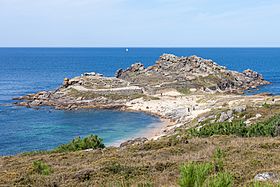Castro de Baroña facts for kids

Castro de Baroña in 2014
|
|
| Location | Porto do Son, Galicia, Spain |
|---|---|
| History | |
| Founded | 1st Century BC |
| Abandoned | 1st Century AD |
| Periods | Iron Age |
| Site notes | |
| Public access | Yes |
The Castro de Baroña is an ancient fortified village from the Iron Age. It is located on a small peninsula in Porto do Son, Galicia, Spain. This settlement was built around the 1st Century BC and people lived there until the 1st Century AD. It was protected by two strong walls and had about twenty round houses, which you can still see today.
Contents
What Was Castro de Baroña Like?
Imagine a village built on a small piece of land sticking out into the sea. To protect it, the people dug a wide and deep ditch, like a moat, across the narrow strip of land connecting the village to the mainland. This was their first line of defense!
Beyond the moat, there was a huge wall made of two stone layers filled with sand and rocks. This wall likely connected to other village walls, creating a safe area.
The main wall is still in good condition. It had different parts, some with three rising stone walls. Near the entrance, there was probably a defensive tower. This tower made the entrance narrower, suggesting there was a gate to stop carts from coming in. It's thought that this wall might have once gone all the way around the fort.
Inside the fort, a sloped path led to the living areas, which were divided into four sections. In one part, people found a fireplace, pottery pieces, and a hole for a post. This suggests it might have been a workshop where they worked with metal. Other oval-shaped buildings were also found near the gate.
Inside the Village
Another part of the village was separated by a wall and reached by stairs. These stairs are some of the best-preserved from ancient forts in Galicia. This area had a group of houses that were sheltered from the wind. A path also led to the highest part of the village, where more old buildings remain.
The people of Castro de Baroña were very self-sufficient. They didn't have water sources like springs or wells inside the fort, so they had to get water from outside. Their main food came from the sea, like shellfish and fish. They also ate meat from cows, goats, and sheep, and even acorns! People living here also worked with metal, built things with stone, and made textiles.
Who Explored This Ancient Site?
Archaeologists are like detectives who dig up clues from the past. The Castro de Baroña was first explored in 1933 by Sebastián González-García. More excavations happened later, led by people like J. M. Luengo (1969-1970) and Francisco Calo Lourido with Teresa Soeiro (1980-1984).
After these digs, Ánxel Concheiro (1984) and Francisco Calo (1985) worked to make the fort stronger and preserve it. New excavations and repairs started again on May 21, 2012, helping us learn even more about this amazing place.
Images for kids
See also
 In Spanish: Castro de Baroña para niños
In Spanish: Castro de Baroña para niños
- List of castros in Galicia
- Castro culture


